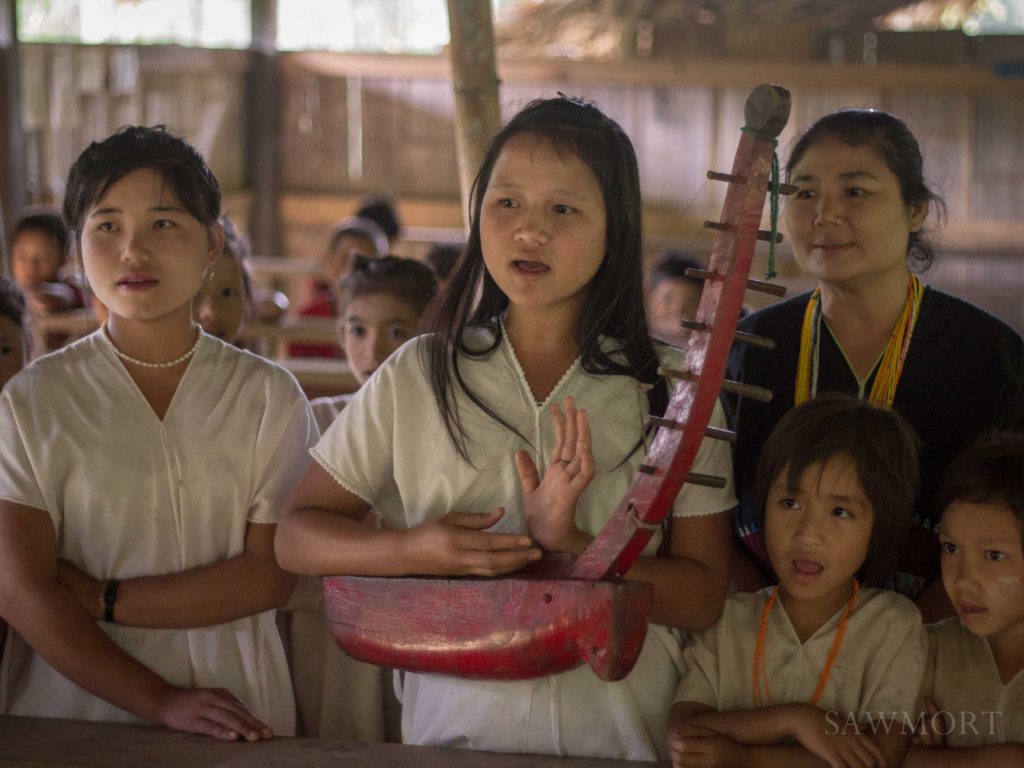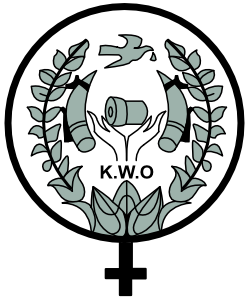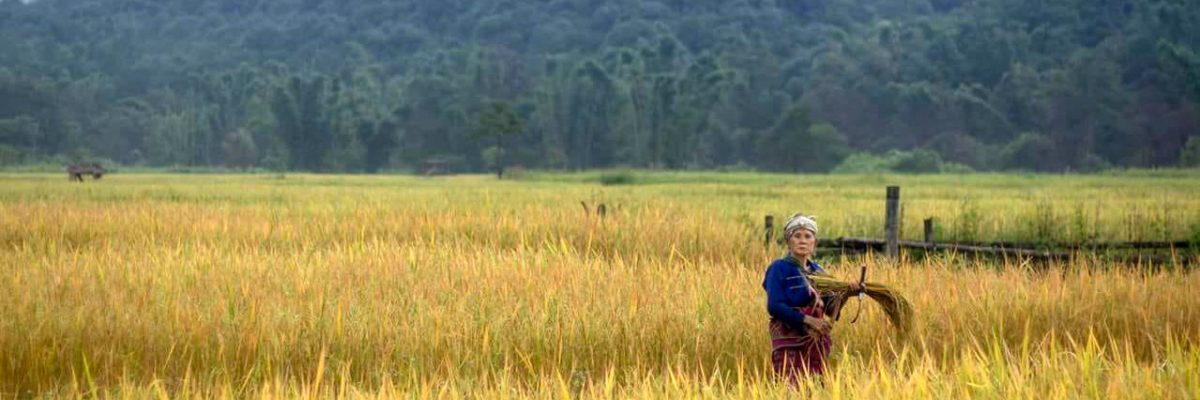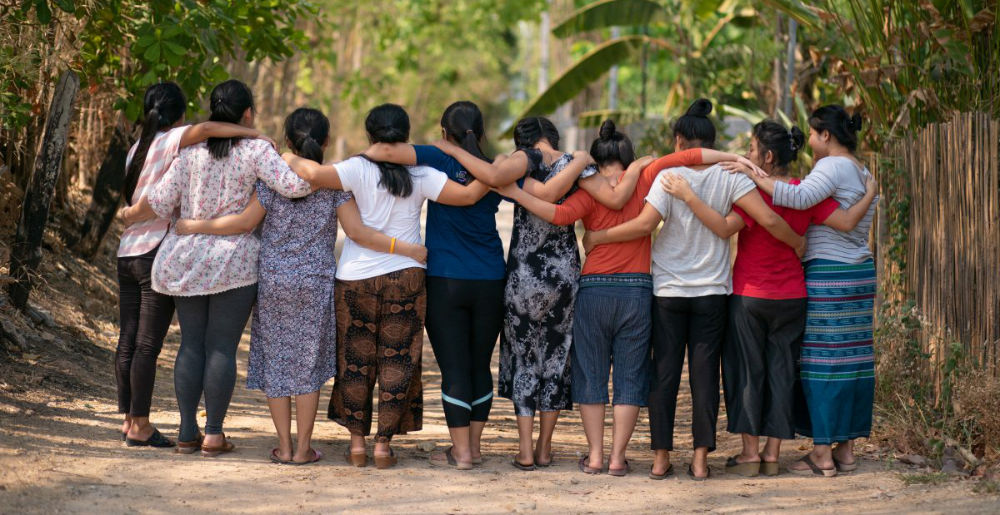
Young Karen girl.
The Karen are a large and dispersed ethnic group of Southeast Asia. They trace their origins to the Gobi Desert, Mongolia, or Tibet. Karen settled in Burma/Myanmar’s southern Irrawaddy Delta area and in the hills along the Salween River in eastern Myanmar and in neighboring Thailand. In the past numerous peoples were considered Karen sub-groups: the Pwo Karen (mostly delta rice-growers), the Sgaw Karen of the mountains; and the Kayahs (also called Karennis), Pa-Os, and Kayans (also called Padaungs), who live in the Karenni and Shan States of Myanmar. Now all of these groups consider themselves distinct ethnic groups. The “Karen Women’s Organisation” are Sgaw Karen women and Pwo Karen women.
The advent of British colonization in Burma in the mid-to-late 19th century affected many of the ethnic people, including the Karen. Contact with American and European Christian missionaries, and associated literacy and education, was welcomed in many villages. The British administrators recruited many Karen people into their police and armed forces. When the Second World War came to Burma, those Karen became loyal guerrilla fighters for the Allies against the Japanese occupiers. Many Karen villages protected or sheltered British soldiers during the war and were subsequently punished and villagers killed by the Japanese soldiers.
As Britain granted Burma independence after the war, Karen politicians hoped for their own nation. Instead Karen, along with other ethnic populations, were to be absorbed into the new Union of Burma (renamed Union of Myanmar in 1989.) Problems began almost immediately, when troops of the predominantly Burmese (Burman) government killed Karen villagers. Karen insurgency sprang up and rapidly gained momentum until it threatened to seize control of the capital, Rangoon. The Karen fighters were driven back by the government troops, and the Burmese military came to dominate the country, eventually taking over power in 1962, pledging to quell rebellion and unify the country by force.
Counter-insurgency tactics (named the “4 Cuts”) intended to subdue resistance by cutting off support from civilians actually drove more Karen into joining the movement for Karen freedom, lead by the Karen National Union (KNU). A consistent pattern of deliberate human rights violations by the Burmese government forces against the ethnic minority civilians has continued to this day, driving tens of thousands of Karen to Thailand as refugees and making the Karen conflict one of the world’s longest.
LOCATION AND HOMELAND
Estimates of the Karen population of Burma vary greatly. There has been no national census inclusive of ethnic peoples in Burma for many decades. Perhaps as many as 6 million Pwo and Sgaw Karen live in Burma, along with some 150,000 Kayahs, 600,000 Pa-Os, 80,000 Kayans, and other related groups. Another 400,000 Karen-ethnic peoples have roots in Thailand, and thousands of others live there as refugees. From 2005 until 2012, large numbers of Karen and Karenni refugees were resettled by UNHCR from refugee camps along the border to international countries, including USA, UK, Norway, Sweden, Australia and Canada.
Karen people (Sgaw and Pwo) live in several regions of southern and eastern Burma and call their homeland “Kaw Thoo Lei”. The largest Karen population is in the Irrawaddy Delta area, a vast agricultural lowland whose main city is Bassein. Another significant region for the Karen is the eastern border with Thailand, where the Dawna Mountain Range stretches down to the Tenasserim River. The area along the mighty Salween River is also inhabited by Karen. Thaton, Papun and Pa-an are towns with major Karen populations.
LANGUAGE
The languages of the Karen are generally considered to be of the Tibeto-Burman family, and the main dialects are Pwo and Sgaw. Some Karen people in isolated hill areas remain illiterate, and those in the Delta region often can speak only Burmese. The languages are widely spoken in many areas and remain a feature of Karen cultural pride. Baptist missionaries developed scripts based on the Burmese alphabet for Pwo and Sgaw Karen languages. An old Pwo script known as “chicken scratch,” because of the shapes of its letters, was devised by Karen Buddhists as well but this is no longer in current use.
In Sgaw Karen, an informal greeting (“How’s it going?”) is “Madee leh?” and a farewell is “Leh mu mu” (“Go pleasantly”). “Thank you” in Sgaw Karen is “Dah blu.”
RELIGION
Many Pwo and Sgaw Karen are Buddhist or Animist. There are also significant populations of Christians, mainly Baptists, and smaller numbers of Seventh Day Adventists and Catholics. There is considerable interplay between animist rituals and Buddhist practices among the Karen. Animists believe in helpful female guardian spirits called “ther myng khae,” and the “lord of land and water,” and local spirits, as well as beneficial and malicious ghosts. The Christians emphasize Bible study and prayer services with hymn singing. Villages tend to be predominantly one or the other of the three religions, while there is a mixture of faiths and houses of worship in the towns. Christian Karen have tried to convert the Buddhists and animists, and Burma’s military government has for many years encouraged conflict between Buddhist Karen and the Christian-led Karen National Union (KNU).
INDIGENOUS CULTURE
Karen indigenous culture is rich in knowledge and customs. Please see the website of our friends at KESAN for more detailed information. (Karen Environment and Social Action Network – https://kesan.asia/). You will find many photos and reports there. KWO promotes awareness of Indigenous Rights in our community through training and information-sharing.
FESTIVALS
The Karen celebrate “New Year” based on a lunar calendar. Sometimes New Year falls in December, and sometimes in January. It is a national holiday and is often the occasion to perform traditional dance and music. Christian Karen celebrate Christmas with caroling trips from village to village. Buddhist Karen hold festivals to mark their religious New Year (in mid-spring) and the end of Lent (post-monsoon). Animists hold crop-protection festivals during the monsoon and after harvest.
RELATIONSHIPS and FAMILY LIFE
For a polite greeting, a Karen holds his or her right elbow in their left hand, and shakes hands with the right. They use the same gesture to give or offer objects to other people. Introductions will include the honorifics Karen use with their names, usually “Saw” for men and “Naw” for women and “Theramu” or “Thra” for teachers (female and male).
Karen are very hospitable and will invite guests to eat with them and, if possible, stay overnight at their house. In traditional Karen bamboo houses, sleeping quarters for guests are on the verandah.
Boys and girls usually meet in school, at festivals, or in youth groups. When a young couple gets involved, love letters and secret messages are often exchanged. In traditional courting, there is always a chaperone present, and sometimes involves the singing of poetry between individuals or groups of boys and girls, asking poetic questions and replying with a rhyming answer. The questions and answers are about romance, but are subtle and symbolic.
Traditionally, either a boy or girl can propose marriage and the whole village is allowed a say in whether their marriage would be appropriate and not offensive to any spirits. Weddings are festive occasions when both the bride’s and groom’s villages come together. The bride changes from her unmarried woman’s long dress to a married woman’s two-part outfit. Marriage is considered to be for life, and among Karen of all faiths, adultery is considered extremely taboo -as an act that can bring catastrophe on the whole village.
Like many cultures in the world, in Karen society women are often considered inferior or subservient to men and both women and men are encouraged to adhere to strict gender roles. Women are seen as the main care-givers, the home maker who is responsible for finding food, preparing meals, cleaning everything, and raising children. Men are expected to find ways to earn income, hunt for animals in the forest, and are responsible for house building. In fact Karen women do a great deal of physically difficult farm work, carry heavy loads and shoulder the burden of keeping a big family in good health, but they are frequently excluded from family and community decision-making processes.
CLOTHING and WEAVING

4 girls at school gate in traditional Karen clothing.
Karen women are known for their fine cotton weaving of clothing, blankets and shoulder bags. The weaving is traditionally done on a small “Backstrap” loom set up in the home, with straps around the waist and attached to the wall, with wooden cross slats. In some areas there are large wooden frame looms as well. The thread is dyed with natural or artificial colors. Young women learn to weave from a young age, and can earn income from this skill throughout life. All Karen people have at least one outfit made of traditional Karen weaving and a Karen bag. The patterns incorporated into the weaving hold traditional meanings. One tunic for a woman takes about two months to weave.
Many Karen men and women now wear mass-produced clothing: T-shirts and trousers for men and blouses with sarongs for women. Younger women sometimes wear blue jeans or long skirts, especially if they are in a town or city. However, traditional Karen clothing is still popular, especially in mountain areas and for special occasions. Traditionally, Pwo and Sgaw Karen wear tunics and sarongs of homespun cotton, dyed red, blue, and black. Men and married women wear a loose tunic over a wrapped sarong. The women’s tunics are often elaborately embroidered with colored thread and seed-beads. The men’s are plainer with fringed hems. Unmarried girls wear simple long white dresses. Men and women often wear a headcloth, and Pwo men sometimes have very long hair worn in side swept ponytails or loose.
FOOD
The staple food of the Karen is rice. Rice is eaten at every meal, and accompanied by a broth soup, vegetables, a chilli paste, and meat or fish if available. Karen eat a wide variety of foods, including what can be gathered from the forest, such as snake, bat, monkey, grubs, bee larvae, ants, palm sugar, wild honey, forest herbs, frog, and lizard. Many types of birds and fish are consumed, and Karen raise chickens, ducks, pigs, cattle.
Because of deforestation, crop confiscation, and rural dislocation, nowadays many Karen have trouble obtaining enough nutrition for their families. Karen refugees and poor villagers typically live on rice, chili peppers, some fish paste, and whatever greens they can gather. The Karen normally eat several helpings of rice at meals and for snacks. They eat mostly polished white rice now, which is less nutritious than red or brown rice. Chewing betel nut is popular among some Karen. Betel nut comes from a species of palm and is combined with leaves and lime paste; it is a mild stimulant and stains the mouth bright red.
MUSIC and DANCE

Karen girl with traditional Karen musical instrument.
Karen music includes traditional songs (many of which are love songs), songs about the land, and Western-influenced Christian hymns. Music that uses the repetitive beat of gongs and drums accompanies such dances as the rice-planting dance and the bamboo dance, as well as wedding processions. In the bamboo dance, sets of 8 to 12 long bamboo poles are placed in a grid. Participants kneel on the ground and bang the poles together in time to the music, while dancers step in and out of the openings in the grid.
The Karen have several traditional musical instruments. The Karen drum is a symbol of the people’s culture. It is round and made of cast bronze, often with figures of frogs and elephants decorating it. The Karen play a harp called the t’na, which has five or six strings and is tuned with pegs along the neck. Another stringed instrument is the large, wooden guitar-like haw tu. The pa ku is a bamboo xylophone played with hammers, and there are bamboo panpipes and mouth-harps of various sizes. A buffalo horn carved into a wind instrument is also a very important traditional Karen sound used in ceremonies. More recently Karen musicians also use imported instruments such as guitars and electric keyboards, especially for Christian church music. The Karen literary tradition is mostly in oral form. There are many hundreds of traditional stories often told in the evenings which teach children or entertain the adults.
SPORTS and GAMES
Soccer and volleyball, are popular sports. Boys play both sports, while Karen girls usually play only volleyball, although more recently we see more teams of girls playing soccer too. Boys and young men play a traditional sport called “chinloh” which is a very acrobatic type of kickball played with a grapefruit-sized ball woven from cane. Even in mountainous areas, Karen villages often have one flat open space where such sports can be played. There are numerous local games that young children play often using local materials such as seeds, or rubber bands, or bamboo.
HISTORY and POLITICS
Burma has been ruled by military dictatorships since 1962. The dictatorship, wanting to end sanctions and their international pariah status, while maintaining their control of the country, embarked on a series of reforms. The first step in that reform process was to bring in an undemocratic constitution, which legalised dictatorship with a civilian front. Rigged elections held by the military regime in November 2010 brought in the new constitution, and a new military-backed government led by former senior general Thein Sein. The transition saw a change from direct military dictatorship to a more ‘ordinary’ authoritarian regime.
In elections in November 2015, the National League for Democracy (NLD), led by Aung San Suu Kyi, won a landslide victory. This brought an end to more than fifty years of military rule and introduced a hybrid system of military rule and democracy.
The elections marked another step in the military’s carefully planned transition from direct military rule to a hybrid military and civilian government, which is accepted by the international community and sections of Burmese society. Burma’s 2008 Constitution was drafted by the military dictatorship to present the appearance of democracy, while maintaining ultimate military control.
Under the Constitution, the new National League for Democracy government were forced to share power with the military and had limited scope to prevent some of the most serious human rights abuses from continuing. The military remained in control of key areas such as the police, security services and much of the justice system. The army remained beyond the control of any civilian government and free to continue attacks against ethnic people. With the military guaranteed 25% of the seats in parliament, they continued to hold a veto over efforts to make the Constitution more democratic.
The 2008 military constitution banned Aung San Suu Kyi from becoming President, but since 2016 she was de facto leader of the Burmese government in the position of State Counsellor.
The Burmese army has continued to commit serious human rights abuses, including rape, torture, executions, forced labour, use of child soldiers, and deliberately targeting civilians. Many of these abuses violate international law and could be classified as war crimes, crimes against humanity and genocide. Neither the military nor the NLD have respected human rights.
The NLD won an overwhelming victory in the general election in November 2020. The military backed political party suffered a crushing defeat in the election.
On 1 February 2021, the day when the newly elected MPs were due to convene to choose the President, the military in Burma staged a coup. The Burmese military, led by Min Aung Hlaing, arrested many political leaders and human rights activists, including Aung San Suu Kyi and President Win Myint, in night time raids.
They declared a state of emergency for one year, and said new elections would be held only after a series of conditions have been met, including an investigation into electoral fraud and economic recovery from the COVID pandemic. The military used false claims of fraudulent votes in the election to justify their coup. There is no evidence of any significant fraudulent voting in the election.
Burma is a country of many different ethnicities and religions but the military sees this as a threat and refuses to give rights and protection to Burma’s ethnic minorities. There cannot be democracy or lasting peace and stability in Burma until the rights of ethnic people are protected and their call for more autonomy is granted.
Ethnic groups in Burma
The failure to address the concerns of Burma’s ethnic groups lies at the heart of Burma’s problems. Burma’s ethnic minorities have been struggling for ethnic and political rights for decades as successive dictators in Burma have pursued a policy of ‘Burmanisation’, which ranges from repressing the teaching of ethnic history, language and culture, to military attacks against civilians.
Lack of a reliable census makes it impossible to more than roughly estimate the composition of Burma’s ethnic mosaic or its total population. Some experts suggest existing population data is skewed to exaggerate the number of Burman, who are the largest single ethnic group. According to available statistics, they comprise about two-thirds of Burma’s approximately 50 million people, and dominate the army and government. Most of Burma’s ethnic minorities inhabit areas along the country’s mountainous frontiers. Karen and Shan groups comprise about 10% each, while Akha, Chin, Chinese, Danu, Indian, Kachin, Karenni, Kayan, Kokang, Lahu, Mon, Naga, Palaung, Pao, Rakhine, Rohingya, Tavoyan, and Wa peoples each constitute 5% or less of the population.
Burma has experienced a long history of migration and conflict among various ethnic groups along fluid frontiers, which were finally fixed only during British imperial rule from the 1820s to 1948. Under British control, diverse peoples far from Rangoon were brought under at least nominal central administration. Yet many areas remained effectively self-ruled, with only a thin veneer of imperial oversight. During World War II, while many Burman joined Japanese forces, many minority ethnic groups remained loyal to Britain. This reflected a genuine desire for independence on the part of both groups; Burmans struggling to be free of the British colonial yoke, and ethnic minorities wishing to escape Burman domination.
The Union of Burma became independent in I948 only after extensive negotiations led by General Aung San, who convinced most ethnic minority groups to join the new union. The Panglong Agreement of 1947 outlined minority rights and specifically gave the Shan and Karenni peoples the option to secede from the union a decade after independence. Yet these constitutional guarantees were never fully respected. Almost immediately upon independence, Burma was thrown into a series of brutal ethnic wars that have continued with varying intensity to this day.
The principal demands of Burma’s ethnic minorities are to gain genuine autonomy for their home areas and to achieve a significant voice in the affairs of the country as a whole. Since its 1988 coup, the State Law and Order Restoration Council (SLORC) (renamed the State Peace and Development Council in November I 997), has negotiated cease-fires with most armed ethnic opposition groups and waged fierce assaults against others. Muslim Rohingya people in southwestern Burma were targeted in 1991, and over 250,000 fled to neighboring Bangladesh.
At least 140,000 more Karen, Karenni, and Mon people from eastern Burma are refugees in Thailand following intense Burmese army offensives since 1984. Many Shan people have been forced to flee army assaults as well. In several areas, there are massive numbers of Internally Displaced Persons (IDPs), mostly villagers who have fled their homes to escape conscription as military porters or other abuses. The suffering of Burma’s estimated 600,000 IDPs is often far worse than refugees in neighboring countries, who receive at least some outside aid.
Among the earlier cease-fires concluded were with ethnic Wa and Kokang armies, which until 1987 served under the Burmese Communist Party. The Burmese army’s agreements with these groups permit opium cultivation and the right to trade without interference. The result has been a sharp increase in heroin production and smuggling from Burma and a concurrent worldwide rise in heroin use and addiction. These groups are now also engaged in large-scale illicit manufacture of methamphetamines. Some other ethnic opposition organisations, particularly the Kachin Independence Organization and the Karen National Union, have taken strong stands against drug production and trafficking. The junta has exploited divisions within and among ethnic groups to bolster its rule. In 2000, the relocation of thousands of Wa farmers into traditional Shan areas raised tensions and sparked fighting between those groups.
The regime’s new constitution, which came into force after the fake elections in November 2010, not only guarantees continued dictatorship, but also denies any ethnic rights. It does not grant ethnic people any real level of autonomy, or grant any protection or promotion of ethnic cultures. There cannot be democracy or lasting peace and stability in Burma if the rights of ethnic people continue to be ignored.
BIBLIOGRAPHY
Falla, Jonathan. Truelove and Bartholomew: Rebels on the Burmese Border. Cambridge: Cambridge University Press, 1991.
Karen Human Rights Group. www.khrg.org (18 April 2008)
Mirante, Edith T. Burmese Looking Glass: A Human Rights Adventure. New York: Grove Press, 1993.
Phan, Zoya. “Little Daughter”.
Smith, Martin. Ethnic Groups in Burma. London: Anti-Slavery International, 1994.
Thornton, Phil. Restless Souls: Rebels, Refugees, Medics and Misfits on the Thai-Burmese Border. Bangkok: Asia Books, 2006.
Thwe, Pascal Khoo. From the Land of Green Ghosts: A Burmese Odyssey. New York: HarperCollins, 2002.



